Related Research Articles

A trans-Neptunian object (TNO), also written transneptunian object, is any minor planet or dwarf planet in the Solar System that orbits the Sun at a greater average distance than Neptune, which has a semi-major axis of 30.1 astronomical units (AU).
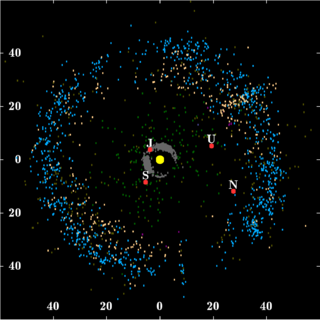
In planetary astronomy, a centaur is a small Solar System body with either a perihelion or a semi-major axis between those of the outer planets. Centaurs generally have unstable orbits because they cross or have crossed the orbits of one or more of the giant planets; almost all their orbits have dynamic lifetimes of only a few million years, but there is one known centaur, 514107 Kaʻepaokaʻawela, which may be in a stable orbit. Centaurs typically exhibit the characteristics of both asteroids and comets. They are named after the mythological centaurs that were a mixture of horse and human. Observational bias toward large objects makes determination of the total centaur population difficult. Estimates for the number of centaurs in the Solar System more than 1 km in diameter range from as low as 44,000 to more than 10,000,000.
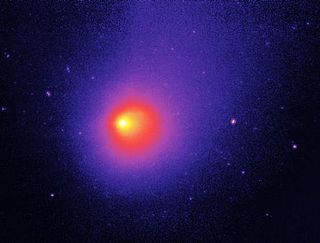
Comet 29P/Schwassmann–Wachmann, also known as Schwassmann–Wachmann 1, was discovered on November 15, 1927, by Arnold Schwassmann and Arno Arthur Wachmann at the Hamburg Observatory in Bergedorf, Germany. It was discovered photographically, when the comet was in outburst and the magnitude was about 13. Precovery images of the comet from March 4, 1902, were found in 1931 and showed the comet at 12th magnitude.
8405 Asbolus is a centaur orbiting in the outer Solar System between the orbits of Jupiter and Neptune. It was discovered on 5 April 1995, by James Scotti and Robert Jedicke of Spacewatch (credited) at Kitt Peak Observatory in Arizona, United States. It is named after Asbolus, a centaur in Greek mythology and measures approximately 80 kilometers in diameter.
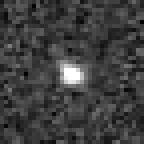
7066 Nessus is a very red centaur on an eccentric orbit, located beyond Saturn in the outer Solar System. It was discovered on 26 April 1993, by astronomers of the Spacewatch program at the Kitt Peak National Observatory in Tucson, Arizona. The dark and reddish minor planet is likely elongated and measures approximately 60 kilometers in diameter. It was named after Nessus from Greek mythology.
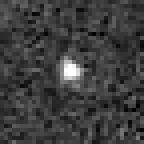
10370 Hylonome (; prov. designation: 1995 DW2) is a minor planet orbiting in the outer Solar System. The dark and icy body belongs to the class of centaurs and measures approximately 72 kilometers (45 miles) in diameter. It was discovered on 27 February 1995, by English astronomer David C. Jewitt and Vietnamese American astronomer Jane Luu at the U.S. Mauna Kea Observatory in Hawaii, and later named after the mythological creature Hylonome.
60558 Echeclus is a centaur, approximately 84 kilometers (52 miles) in diameter, located in the outer Solar System. It was discovered by Spacewatch in 2000 and initially classified as a minor planet with provisional designation 2000 EC98 (also written 2000 EC98). Research in 2001 by Rousselot and Petit at the Besançon observatory in France indicated that it was not a comet, but in December 2005 a cometary coma was detected. In early 2006 the Committee on Small Bodies Nomenclature (CSBN) gave it the cometary designation 174P/Echeclus. It last came to perihelion in April 2015, and was expected to reach about apparent magnitude 16.7 near opposition in September 2015.
52872 Okyrhoe is a centaur orbiting in the outer Solar System between Jupiter and Saturn. It was discovered on 19 September 1998, by the Spacewatch survey at Kitt Peak Observatory in Arizona, United States, and named after Ocyrhoe from Greek mythology.

55576 Amycus is a centaur discovered on 8 April 2002 by the NEAT at Palomar.
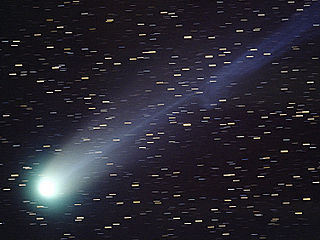
An interstellar object is an astronomical object in interstellar space that is not gravitationally bound to a star. This term can also be applied to an object that is on an interstellar trajectory but is temporarily passing close to a star, such as certain asteroids and comets. In the latter case, the object may be called an interstellar interloper.
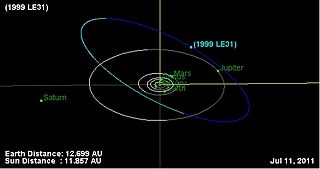
1999 LE31 is a centaur and damocloid on a retrograde and eccentric orbit from the outer region of the Solar System. It was first observed on 12 June 1999, by astronomers with the LINEAR program at the Lincoln Lab's ETS near Socorro, New Mexico, in the United States. The unusual object measures approximately 16.8 kilometers (10 miles) in diameter.
(148975) 2001 XA255, provisional designation: 2001 XA255, is a dark minor planet in the outer Solar System, classified as centaur, approximately 38 kilometers (24 miles) in diameter. It was discovered on 9 December 2001, by David C. Jewitt, Scott S. Sheppard, and Jan Kleyna observing from the Mauna Kea Observatory. The object is currently trapped in a 1:1 mean-motion resonance with Neptune following a path of the horseshoe type.
2010 EU65 is a centaur, approximately 64 kilometers (40 miles) in diameter, orbiting the Sun in the outer Solar System. The object is also a promising Uranus horseshoe librator candidate. It was first observed on 13 March 2010, by American astronomers David Rabinowitz and Suzanne Tourtellotte, observing from Cerro Tololo and La Silla Observatory in Chile. As of 2021, it has neither been numbered nor named.
Asteroid 2011 QF99 is a minor planet from the outer Solar System and the first known Uranus trojan to be discovered. It measures approximately 60 kilometers (37 miles) in diameter, assuming an albedo of 0.05. It was first observed 29 August 2011 during a deep survey of trans-Neptunian objects conducted with the Canada–France–Hawaii Telescope, but its identification as Uranian trojan was not announced until 2013.

40P/Väisälä is a periodic comet that was discovered on February 8, 1939. Its orbit was determined on April 26, 1939. In 1994, the diameter of its nucleus was found to be 4.2 km, similar in size to that of Comet Encke.
(82158) 2001 FP185, provisional designation 2001 FP185, is a highly eccentric trans-Neptunian object from the scattered disc in the outermost part of the Solar System, approximately 330 kilometers in diameter. It was discovered on 26 March 2001, by American astronomer Marc Buie at Kitt Peak National Observatory in Arizona, United States.
(606357) 2017 UV43 is a centaur from the outer Solar System, approximately 8 kilometers (5 miles) in diameter. It was discovered by the Mount Lemmon Survey on 13 March 2005. The unusual minor planet follows an orbit similar to those of the fragments of comet Shoemaker–Levy 9. This minor planet was numbered (606357) by the Minor Planet Center on 27 October 2021 (M.P.C. 136418). As of November 2021, it has not yet been named.
(342842) 2008 YB3, provisional designation: 2008 YB3, is a sizable centaur and retrograde damocloid from the outer Solar System, approximately 67 kilometers (42 miles) in diameter. It was discovered on 18 December 2008, by astronomers with the Siding Spring Survey at the Siding Spring Observatory in Australia. The minor planet was numbered in 2012 and has since not been named.
2011 MM4, provisional designation: 2011 MM4, is a sizable centaur and retrograde damocloid from the outer Solar System, approximately 64 kilometers (40 miles) in diameter. It was discovered on 24 June 2011, by astronomers with the Pan-STARRS 1 at the Haleakala Obs. in Hawaii.

2I/Borisov, originally designated C/2019 Q4 (Borisov), is the first observed rogue comet and the second observed interstellar interloper after ʻOumuamua. It was discovered by the Crimean amateur astronomer and telescope maker Gennadiy Borisov on 29 August 2019 UTC.
References
- 1 2 3 "JPL Small-Body Database Browser: 2020 MK4" (2020-06-06 last obs.). Jet Propulsion Laboratory . Retrieved 5 April 2021.
- ↑ "Orbit Fit and Astrometric record for 20MK4". Southwest Research Institute . Retrieved 11 August 2021. The Deep Ecliptic Survey Object Classifications
- 1 2 3 4 5 6 7 de la Fuente Marcos, C.; de la Fuente Marcos, R.; Licandro, J.; Serra-Ricart, M.; Martino, S.; de Leon, J.; Chaudry, F.; Alarcón, M. R. (13 May 2021). "The active centaur 2020 MK4". Astronomy & Astrophysics . 649 (1): A85 (15 pages). arXiv: 2104.01668 . Bibcode:2021A&A...649A..85D. doi:10.1051/0004-6361/202039117. S2CID 233024896.
- ↑ "MPEC 2020-N36: 2020 MK4". Minor Planet Center . Retrieved 5 April 2021.
- ↑ "2020 MK4 belatedly confirmed outburst". Minor Planet Mailing List . Retrieved 6 April 2021.
- ↑ Horner, J.; Evans, N.W.; Bailey, M. E. (2004). "Simulations of the Population of Centaurs I: The Bulk Statistics". Monthly Notices of the Royal Astronomical Society . 354 (3): 798. arXiv: astro-ph/0407400 . Bibcode:2004MNRAS.354..798H. doi:10.1111/j.1365-2966.2004.08240.x. S2CID 16002759.